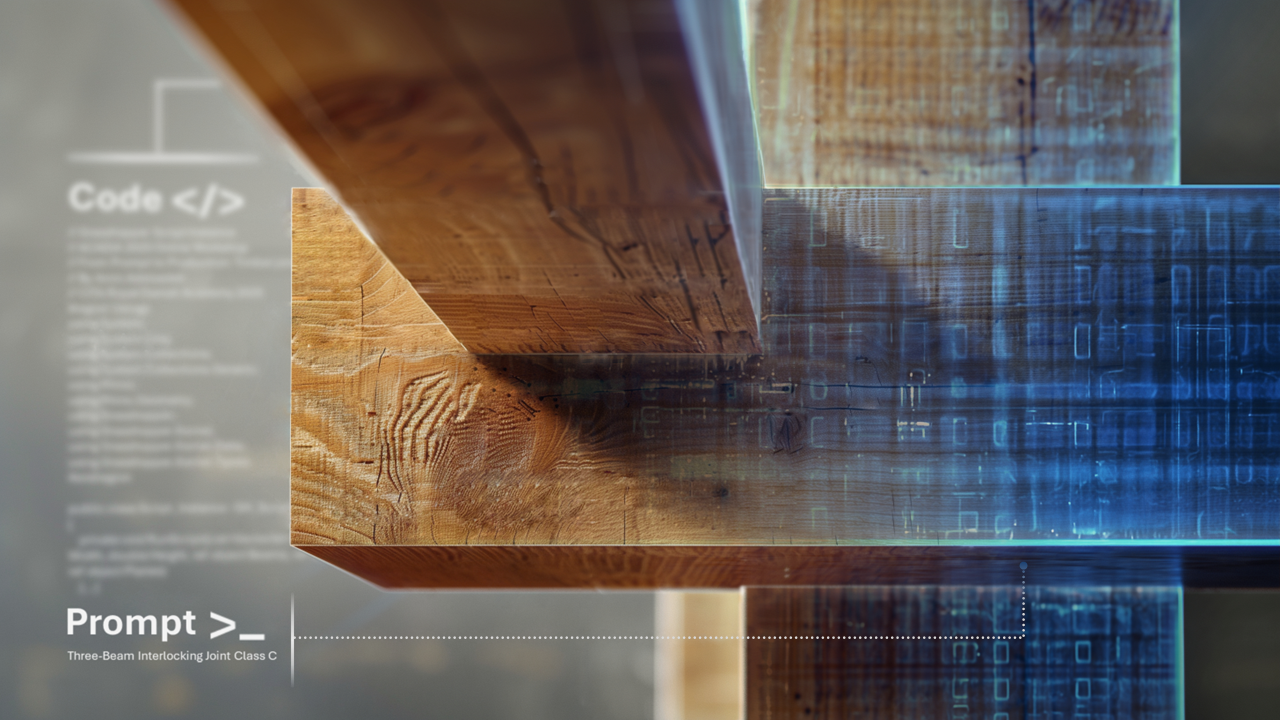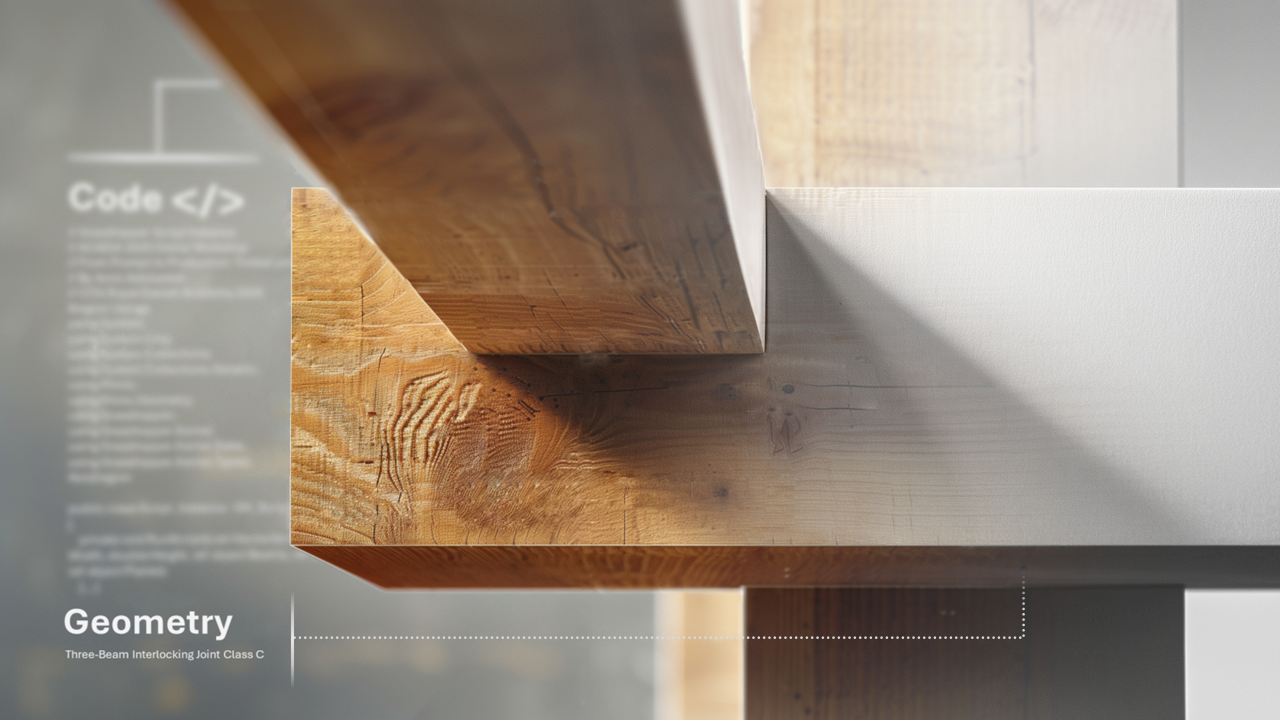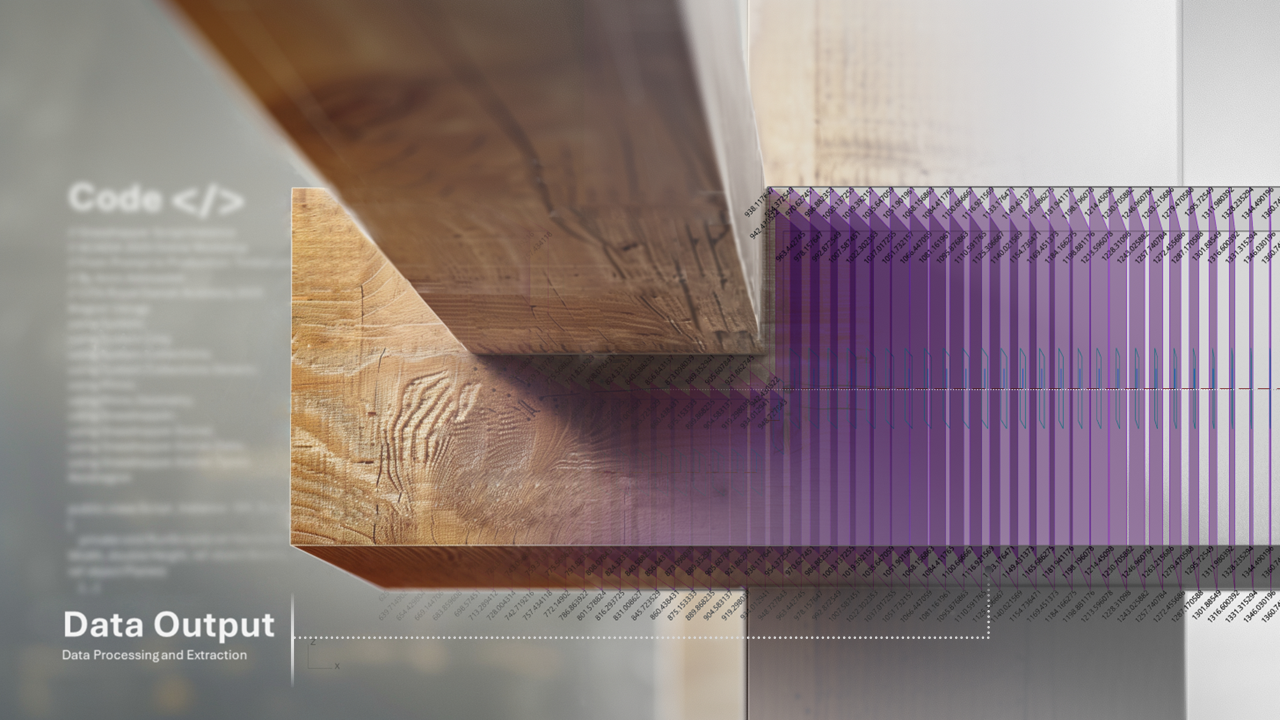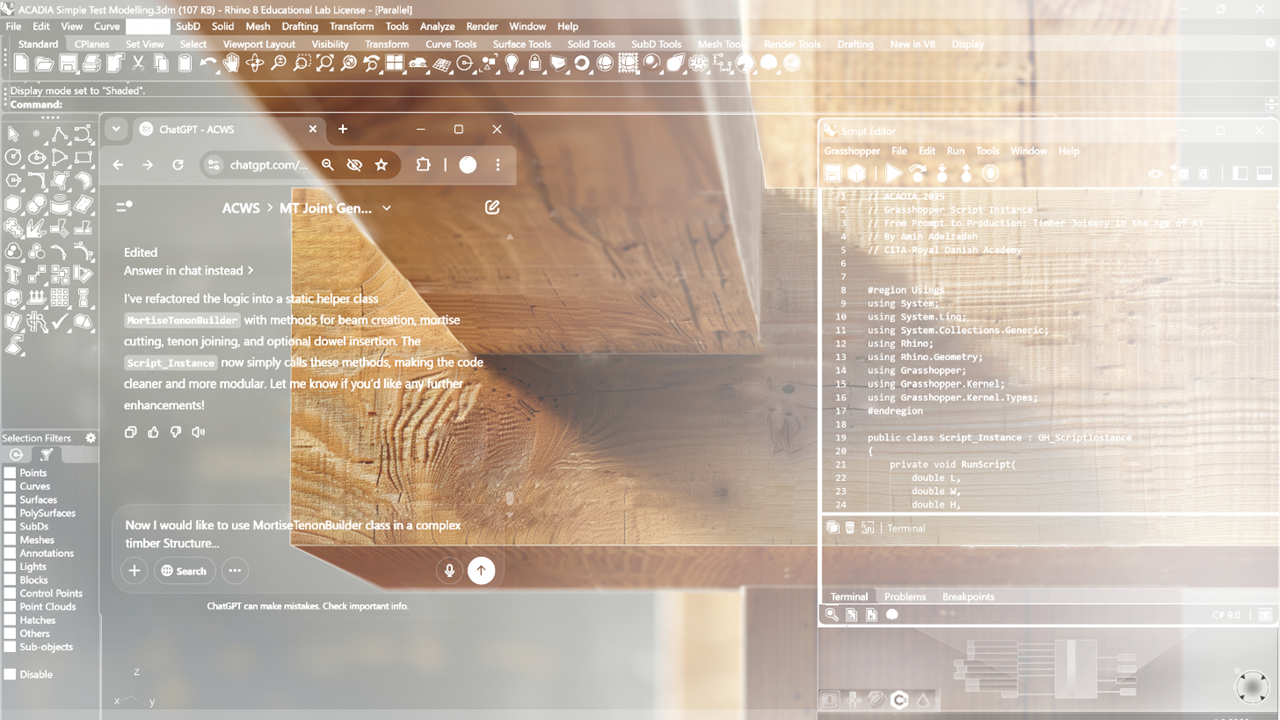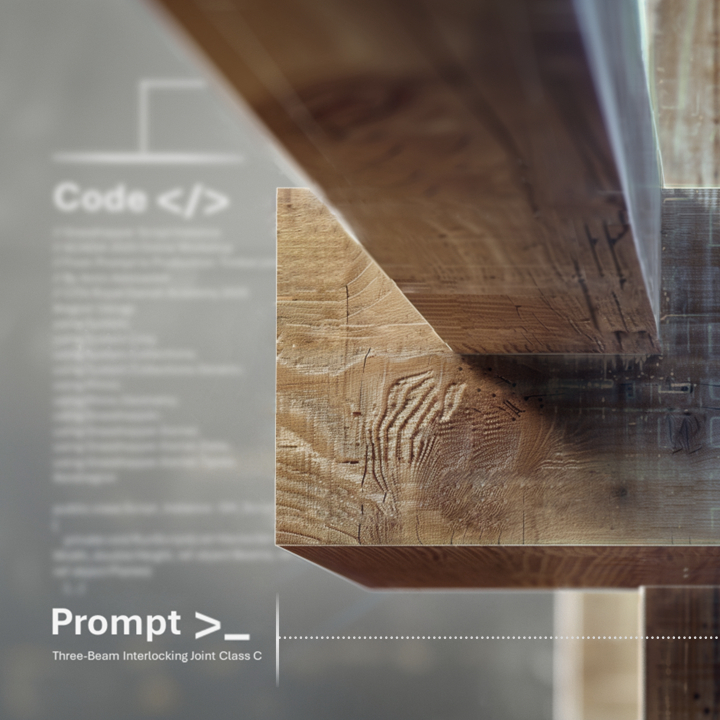
From Prompt to Production: Timber Joinery in the Age of AI
Registration Link
Workshop Registration opens September 8th, 2025! Click the link above to be notified when registration becomes available.
Refund and Change Policy
Important: Refund and change requests will not be accepted beyond Monday, October 20th.
Location : Online
Workshop Team
Instructor: Amin Adelzadeh
Doctoral Fellow, CITA - Royal Danish Academy, Denmark
Guest Critics:
Prof. Mette Ramsgaard Thomsen and Prof. Martin Tamke
CITA - Royal Danish Academy, Denmark
The workshop will conclude with a session where participants’ outcomes may be reviewed by CITA faculty critics, offering expert feedback and recommendations, subject to their availability.
Workshop Description
This intensive two-day online workshop introduces participants to the future of timber design workflows, where conversational AI acts as a collaborator in crafting complex joinery systems. By exploring a fully automated design-to-fabrication pipeline, attendees will learn how to translate natural-language prompts into production-ready C# code, directly executable within Rhino’s Grasshopper environment.
The focus is on generating comprehensive digital outputs—custom parametric components, joint typologies, and fabrication-ready datasets—establishing a seamless prompt-to-code and code-to-geometry workflow. Participants will leave with a library of diverse joinery solutions and tools for integrating AI-driven design into their own timber projects.
Keywords
AI-Driven Design, Prompt Engineering, Computational Timber Design, Timber Joinery Systems, Fabrication Data Automation
Learning Objectives
By completion of the workshop, participants will be able to:
- Engineer Effective Prompts: Craft clear, unambiguous natural-language prompts to define joint typologies, dimensions, and input/output data structures for automated C# code generation
- Steer AI Code Generation: Configure system and user prompts to guide ChatGPT in producing clean, modular C# scripts compatible with Grasshopper’s scripting API
- Develop a Joinery Library: Generate a variety of joint systems—from finger and lap joints to bespoke connections—within a unified prompt framework
- Create Custom Grasshopper Components: Build and refine tailored C# components for rapid deployment across timber models
- Integrate and Test Components: Apply generated components within structural models (frames, trusses), managing data trees and geometric alignment
- Iterate and Debug: Use prompt-and-test cycles to refine code, add UI elements, and handle errors for robust workflows
Intended Outcomes
Participants will leave the workshop with:
- A prompt-to-C# workflow template for generating custom Grasshopper components on demand
- A library of parametric joinery components, designed for automated application in timber structures
- A worked example structural model (e.g., a frame or grid) populated with bespoke joints
- Comprehensive documentation, including prompt samples, code snippets, and step-by-step guides
- Strategies for scaling and automating the pipeline, such as macro scripting, version control, and library management
This workshop delivers a focused, Grasshopper-only workflow that combines conversational AI with parametric design, enabling participants to prototype and implement custom timber joinery systems directly from natural-language prompts.
Technical Constraints & Requirements
Software
- Rhino 7 (or later) with Grasshopper
- Access to a GPT-based model (e.g., via OpenAI API or Web UI)
Hardware
- Laptop with at least 16 GB RAM and Windows or macOS compatible with Rhino
Dependencies
- No additional plugins beyond standard Grasshopper components; all scripting done in native C# or Python scripting components
Participant Information
To ensure everyone can hit the ground running, the following familiarity is preferred but not required—enthusiastic beginners are welcome:
- Rhino & Grasshopper: Familiarity with navigating Rhino 7+ and assembling basic Grasshopper definitions
- Scripting in Grasshopper: Familiarity with reading or writing simple Python or C# scripts within Grasshopper’s scripting components
- AI Prompting: Familiarity with formulating natural-language prompts using a GPT-based model
- Hardware & Software Setup: Laptop (Windows or macOS) with at least 16 GB RAM and Rhino 7+ installed, active access to a GPT model (via API key or web interface)
- Basic Timber Joinery Knowledge: Familiarity with common joinery types or a willingness to learn and to iterate on design
Participants without prior experience in any of these areas will still be able to follow along and learn through guided instruction.
Workshop Schedule
Workshop Duration: 2 Days (Tuesday, Nov. 4 - Wednesday, Nov. 5)
Workshop Attendees: 15–25 participants
Day 1 – Tuesday, November 4: Foundations and Basic Joint Generation
| Time | Session | Details |
|---|---|---|
| 09:00 – 09:30 | Welcome, Introductions, Overview | Overview of the prompt → C# → Grasshopper workflow |
| 09:30 – 11:00 | Prompt Engineering Fundamentals | Crafting clear prompts for timber joinery; defining inputs, outputs, success criteria |
| 11:00 – 11:15 | Break | — |
| 11:15 – 12:45 | ChatGPT for C# Code Generation | Configuring prompts; generating a joint component template |
| 12:45 – 13:45 | Lunch | — |
| 13:45 – 15:15 | Mapping Prompts to Grasshopper C# | Anatomy of a GH C# component; reusable scaffolds for joint types |
| 15:15 – 15:30 | Break | — |
| 15:30 - 17:00 | Hands-On Lab: Generate & Test Joints | Live demo; importing, debugging, running in Grasshopper |
Day 2 – Wednesday, November 5: Refinement and Structural Integration
| Time | Session | Details |
|---|---|---|
| 09:00 – 09:15 | Recap & Q&A | Review of Day 1 |
| 09:15 – 10:45 | Refining Generated Code | Adding UI inputs, defaults, validation; iterative testing |
| 10:45 – 11:00 | Break | — |
| 11:00 – 12:30 | Developing a Joint System | Designing a family of joints; unified prompt framework |
| 12:30 – 13:30 | Lunch | — |
| 13:30 – 15:00 | Structural Model Integration | Frame/grid setup in Grasshopper; integrating joint components |
| 15:00 – 15:15 | Break | — |
| 15:15 – 17:00 | Hands-On Project & Showcase | Build & populate a frame with chosen joints; final group demo & feedback |
About the Instructor
Amin Adelzadeh is a researcher and educator and currently a doctoral fellow at CITA – the Royal Danish Academy in Copenhagen, Denmark, as part of the EIC Pathfinder research project. He specializes in digital technologies for circular timber construction, with a strong focus on developing non-destructive assessment and optimization methods for the adaptive fabrication of resource-driven timber assemblies.
Throughout his career, he has held research and teaching positions at Augsburg Technical University of Applied Sciences, Chalmers University of Technology, Bremen University of Applied Sciences, TU Kaiserslautern, and Politecnico di Milano. Amin has led design studios, seminars, and technical workshops on low-cost, material-efficient, and rapid assembly-and-disassembly workflows for modular timber topologies.
His teaching contributions have spanned SIGraDI 2024, ECAADE 2024, SIGraDI 2023, CAADRIA 2023, DigitalFUTURES 2023, and ACADIA 2022, and he has delivered lectures at numerous other international venues. His research has been widely published and presented at leading conferences and industry events.
Amin serves on the scientific paper review committees for the International Journal of Architectural Computing (IJAC), CAADRIA, SIGraDI, and ECAADE conferences in Europe. He holds an M.Sc. in Architecture from Politecnico di Milano, awarded with merit-based scholarships.
Acknowledgements
The works leading to this workshop has received funding from the European Research Council (ERC) under the European Union’s Horizon 2020 research and innovation programme (grant agreement No 101019693) and the EIC Pathfinder Project “RAW: Computation for a New Age of Resource Aware Architecture: Waste-Sourced and Fast-Growing Bio-Based Materials” - Project 101161441.

